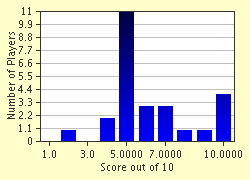Quiz Answer Key and Fun Facts
1. The first definite signs of a permanent establishment in what is now Copenhagen date from 1167 and are called what after a Danish bishop who defended Copenhagen from invaders. What was that building?
2. When Copenhagen was emerging as a powerful city during the 12th and 13th centuries, what was its biggest industry?
3. Which Danish King, who was also King of Norway and Sweden, failed to take Schleswig from the Holy Roman Empire and saw Copenhagen fall into economic turmoil when he took the throne in 1396?
4. Dyrehavsbakken was the first of its kind when it opened in 1583 and is still the oldest one in operation worldwide. What is Dyrehavsbakken?
5. Which of the following was NOT a means by which King Christian IV vastly improved Copenhagen's position in Europe, particularly among the Nordic countries during his reign from 1596-1648?
6. A devastating fire that destroyed a third of Copenhagen in 1728 left about 20% of the city's population homeless and burnt many of the original works of which Danish astronomer, who has a huge planetarium named after him in Copenhagen?
7. In both the 1801 Battle of Copenhagen and that of 1807, Denmark fought which European power?
8. 1913 saw the debut of which popular statue in Copenhagen that is based on a Hans Christian Andersen fairy tale?
9. What was the name of the British led invasion of Copenhagen on March 21, 1945 to free the city from the Nazis during World War II?
10. Opened in 2000, the Oresund Bridge connects Copenhagen to which foreign city across the Oresund Strait?
Source: Author
Joepetz
This quiz was reviewed by FunTrivia editor
bloomsby before going online.
Any errors found in FunTrivia content are routinely corrected through our feedback system.

